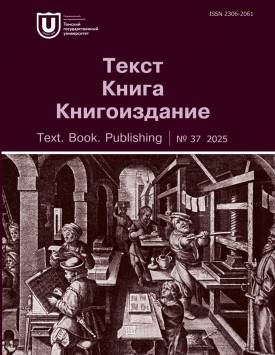Amateur student journals: The emergence of creolized texts in Siberia
The aim of the article is to consider the history of the creolized text (CT) based on Siberian materials of the late 19th century. As a special case of such a text amateur student journals published in Tomsk are considered. Previously this type of materials has not been used to study the history of CT. As an example, the journals RodnayaSibir'. [Native Siberia] and Les [Forest] are used. They are stored in the funds of the Tomsk State University Research Library and the Tomsk Regional Museum of Local History. The journal Rodnaya Sibir' is represented by two issues for 1918-1919; it was published by students of the Mirkovich Female Gymnasium and the Alekseevsky Real School. The journal had a pro-regional character. Les was also published in Tomsk in 1917; nothing is known about its editorial board. Its authors and publishers hid behind pseudonyms: "Ethiop", "Black Hawk", "Founding". The peculiarity of the non-typesetting technique of replication in both cases involved the creation of an original for printing, including a ready-made layout of each folio: with text and illustration at once. This meant that the artist and copyist (original maker) had to work in collaboration, planning in advance the layout of the text and illustrations. Also, official children's journals of the corresponding period were used for comparison: Yunyy chitatel' [Young Reader], Dlya nashikh detey [For Our Children], Nezabudka [Forget-Me-Not]. In the course of the study, the comparative method was used first of all. The following parameters were compared: the presence of the original display font; the presence of ornamental decorations that are visually related to the text (for example, heading); the presence of the texts in a plot or ornamental frame; actually CT: the image of the object that is the carrier of the texts, rebuses. In the issues of the journals, several variants of such phenomena that can be attributed to CT were identified in all parameters listed above. Similar examples are given from official children's journals of the same period. The publishers and artists of the described amateur publications were familiar with the official contemporary periodicals and adopted some design techniques from there, including elements of CT. Thus, the elements of CT were not just part of the reading environment for the creators of amateur journals, but were perceived as something necessary and as part of their own creativity. Moreover, if we take into account the findings of a previously published article on comics among the Old Believers, it is obvious that the phenomenon of CT was very widespread. From this, it can be concluded that the phenomenon of CT is deeply rooted in the readership of the Siberian city of the late 19th - early 20th centuries. The author declares no conflicts of interests.
Keywords
Siberia, amateur student journals, rebus, creolized textAuthors
| Name | Organization | |
| Esipova Valeriya A. | Tomsk State University | esipova_val@mail.ru |
References

Amateur student journals: The emergence of creolized texts in Siberia | Tekst. Kniga. Knigoizdanie - Text. Book. Publishing. 2025. № 37. DOI: 10.17223/23062061/37/5
